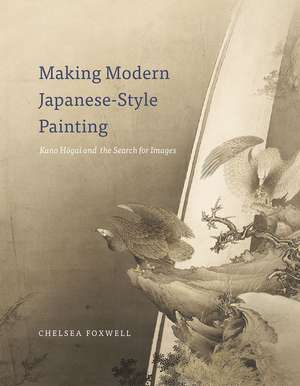Making Modern Japanese-Style Painting: Kano Hogai and the Search for Images
Autor Chelsea Foxwellen Limba Engleză Hardback – 20 iul 2015
The Western discovery of Japanese paintings at nineteenth-century world’s fairs and export shops catapulted Japanese art to new levels of international popularity. With that popularity, however, came criticism, as Western writers began to lament a perceived end to pure Japanese art and a rise in westernized cultural hybrids. The Japanese response: nihonga, a traditional style of painting that reframed existing techniques to distinguish them from Western artistic conventions. Making Modern Japanese-Style Painting explores the visual characteristics and social functions of nihonga and traces its relationship to the past, its viewers, and emerging notions of the modern Japanese state.
Chelsea Foxwell sheds light on interlinked trends in Japanese nationalist discourse, government art policy, American and European commentary on Japanese art, and the demands of export. The seminal artist Kano Hogai (1828–88) is one telling example: originally a painter for the shogun, his art eventually evolved into novel, eerie images meant to satisfy both Japanese and Western audiences. Rather than simply absorbing Western approaches, nihonga as practiced by Hogai and others broke with pre-Meiji painting even as it worked to neutralize the rupture.
By arguing that fundamental changes to audience expectations led to the emergence of nihonga—a traditional interpretation of Japanese art for a contemporary, international market—Making Modern Japanese-Style Painting offers a fresh look at an important aspect of Japan’s development into a modern nation.
Chelsea Foxwell sheds light on interlinked trends in Japanese nationalist discourse, government art policy, American and European commentary on Japanese art, and the demands of export. The seminal artist Kano Hogai (1828–88) is one telling example: originally a painter for the shogun, his art eventually evolved into novel, eerie images meant to satisfy both Japanese and Western audiences. Rather than simply absorbing Western approaches, nihonga as practiced by Hogai and others broke with pre-Meiji painting even as it worked to neutralize the rupture.
By arguing that fundamental changes to audience expectations led to the emergence of nihonga—a traditional interpretation of Japanese art for a contemporary, international market—Making Modern Japanese-Style Painting offers a fresh look at an important aspect of Japan’s development into a modern nation.
Preț: 382.15 lei
Preț vechi: 442.83 lei
-14% Nou
Puncte Express: 573
Preț estimativ în valută:
73.13€ • 76.70$ • 60.87£
73.13€ • 76.70$ • 60.87£
Carte indisponibilă temporar
Doresc să fiu notificat când acest titlu va fi disponibil:
Se trimite...
Preluare comenzi: 021 569.72.76
Specificații
ISBN-13: 9780226110806
ISBN-10: 022611080X
Pagini: 296
Ilustrații: 34 color plates, 70 halftones
Dimensiuni: 216 x 279 x 28 mm
Greutate: 1.47 kg
Editura: University of Chicago Press
Colecția University of Chicago Press
ISBN-10: 022611080X
Pagini: 296
Ilustrații: 34 color plates, 70 halftones
Dimensiuni: 216 x 279 x 28 mm
Greutate: 1.47 kg
Editura: University of Chicago Press
Colecția University of Chicago Press
Notă biografică
Chelsea Foxwell is assistant professor of art history at the University of Chicago.
Cuprins
Acknowledgments
Notes to the Reader
Introduction: Nihonga and the Historical Inscription of the Modern
1 Exhibitions and the Making of Modern Japanese Painting
2 In Search of Images
3 The Painter and His Audiences
4 Decadence and the Emergence of Nihonga Style
5 Naturalizing the Double Reading
6 Transmission and the Historicity of Nihonga
Conclusion
Notes
Bibliography
Index
Notes to the Reader
Introduction: Nihonga and the Historical Inscription of the Modern
1 Exhibitions and the Making of Modern Japanese Painting
2 In Search of Images
3 The Painter and His Audiences
4 Decadence and the Emergence of Nihonga Style
5 Naturalizing the Double Reading
6 Transmission and the Historicity of Nihonga
Conclusion
Notes
Bibliography
Index
Recenzii
“[Foxwell] has a fine eye for analyses of paintings. . . . This messy period is clarified a lot by this book. . . . Highly recommended.”
“Foxwell’s book is scholarly work of the highest order, its primary subject of analysis and the topics developed from it are exceedingly important, and its assiduously developed analysis is substantial and original. Making Modern Japanese-Style Painting not only introduces and contextualizes its subject, it offers an original way of conceptualizing it. In doing so, it serves not only as a significant study in the history of Japanese art, but a significant intervention in art history more broadly.”
“Foxwell makes a crucial and timely contribution to the growing body of studies on the artistic practices upended by Japan’s political transformation from insular feudalism to internationalist constitutional monarchy. Making Modern Japanese-Style Painting provides a fresh and compelling alternative to understanding the late-nineteenth-century nexus of thinkers, producers, and consumers of art.”
“Skillfully bridging the late Edo and Meiji periods, Foxwell has made a major contribution to new art historical scholarship. Questioning any facile overlay of political transformations onto the world of art, as well as conventional notions of Japanese cultural authenticity, she adeptly demonstrates that the highly diverse nineteenth-century Japanese art world was already undergoing massive changes that cannot simply be attributed to the implementation of a top-down governmental system. Her meticulous research is coupled with an impressively broad consideration of larger epistemological questions that make this a valuable text for all scholars and students interested in modern Japan during this period.”
"Taken as a complete text, Making Modern Japanese-Style Painting demonstrates a sophisticated understanding of the visual and cultural politics of the Meiji period, but, equally important, it supplies a useful foundational discussion of pre-Meiji painting. Furthermore, Foxwell is clearly versed in Western modern art history and critical theory, and succeeds in making effective use of this understanding to enhance her ideas and observations without overencumbering them."
